Discover the best things to do in Skopje, North Macedonia. My city guide also includes a detailed Skopje itinerary, Skopje Map, plus my best North Macedonia travel tips to help you make the most of your visit.
Say what you like about Skopje, there’s no denying that this is one of the most intriguing cities in Europe.
I spent a full week in Skopje (pronounced skop-yhee) as part of my 6-month journey around the Balkans. Although it definitely wasn’t my favourite city in the region (that accolade is shared by Tirana and Ljubljana), I definitely found it the most bizarre, and probably the most entertaining.
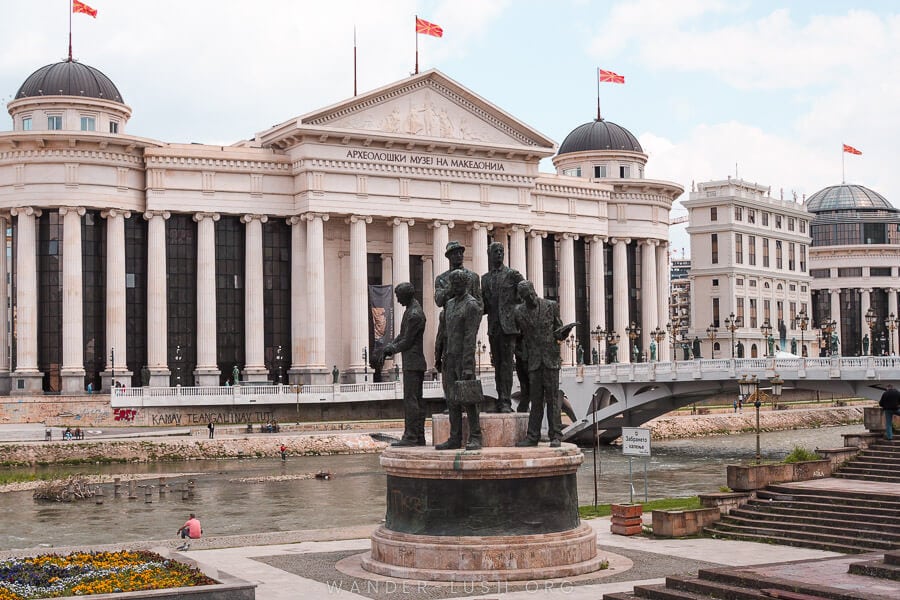
The capital of North Macedonia (itself a bit of an unusual holiday destination), Skopje is roughly divided into two. One half of the city is an expansive Old Bazaar that dates back to Ottoman times, while the other half is all polished facades, manicured parks and a plethora of sculptures and monuments, all erected as part of an ambitious urban project called Skopje 2014 that aimed to make the city appear ‘more classical’.
These two ‘halves’ combine to create a city of ultimate contrasts.
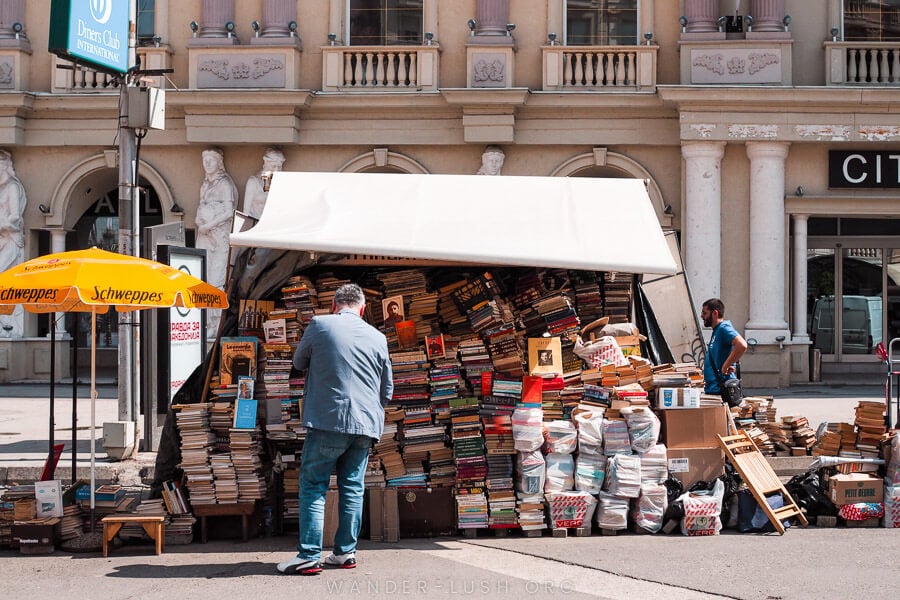
In this list of things to do in Skopje, you’ll find hammams that have been converted into art galleries, brutalist architecture, trendy cafes, a museum dedicated to Skopje’s most famous resident and another to the earthquake that flattened the city in 1963. I’ve also included a detailed guide to the Old Bazaar, the highlight of Skopje for me.
Whether you’re looking for a budget-friendly alternative city break or a place to start a more in-depth North Macedonia itinerary, a day in Skopje is one you won’t soon forget.
Call it weird, whacky, eccentric, crass or even crazy – the one thing Skopje’s definitely got going for it is that it’s completely and utterly memorable.
Planning a trip to North Macedonia? Check out these other resources:
– My guide to Bitola, North Macedonia’s second city.
– My guide to Krusevo, a charming hilltop town in the country’s south.
– My guide to visiting the painted mosque in Tetovo, the best Skopje day trip.
– My North Macedonia Travel Guide, all my posts for the country in one place, along with plenty more travel tips.
Please note: This post contains affiliate links, meaning I may earn a commission if you make a purchase by clicking a link (at no extra cost to you). Learn more.
21 best things to do in Skopje + suggested Skopje itinerary
You only need one day in Skopje (albeit a rather full one) to see the city’s highlights.
For your convenience, I’ve organised my list of the top 21 things to do in Skopje into a logical one-day Skopje itinerary. If you prefer to take things at a slower pace (I spent a whole week in Skopje so I completely understand), you can easily extend this itinerary by spreading the morning and afternoon sections out over 2 or more days.
At the end of the list, you’ll find all these plots plotted on a downloadable map, plus a list of recommended Skopje day trips.
First, here is a quick overview of my Skopje itinerary:
- Morning: Debar Maalo, Saint Clement Church, Macedonia Square, Macedonia Gate, Woman Warrior Park, Art Bridge, Memorial House Mother Teresa, Museum of the City of Skopje.
- Afternoon: Stone Bridge, Daut Pasha Hamam, Destan restaurant, Skopje Old Bazaar, Suli An Local History Museum, Hotel Arka, Bit Pazar, Mustafa Pasha’s Mosque, Ascension of Jesus Church.
- Evening: Skopje Fortress, Brewery Old Town, Pivnica An restaurant.
Morning: New Skopje
1. Start your one day in Skopje with a coffee in Debar Maalo
Debar Maalo is Skopje’s bohemian neighbourhood, characterised by wide tree-lined boulevards, street art and outdoor bars and cafes. There are lots of apartment blocks in this area so if you want to start each day in Skopje’s coolest suburb, you should try to find an Airbnb here. I stayed in this neighbourhood myself and loved it.
Debar Maalo is very central, just west of Skopje’s main square along the river, so you can easily wander here from the centre, too. There are plenty of cafes in downtown Skopje, including around Macedonia Square, but I think this is a much better place to start your morning and get a feel for Skopje’s ‘hip’ side at the same time.
Aminta Treti, Debar Maalo’s main street, is crowded with contemporary cafes (most of which become cocktail bars at night) and kafanas (traditional Macedonian restaurants) where you can grab a morning brew and/or breakfast.
Recommended cafes in Debar Maalo:
- Coffee Factory (from 9am) – often named the best barista coffee in Skopje
- Krug (from 8am) – sit underneath the fig tree
- RadioBar (from 8am) – my local when I visited Skopje
- Bruklinski (from 9am) – come back on Saturday night for live jazz
- Friends Caffe (from 10am) – located further towards the centre
For something more substantial, Staro Skupi is a popular kafana close to the park where you get a traditional North Macedonian breakfast. Simit-pogacha (a bun stuffed with burek), kozinjak (a soft bread flavoured with lemon and dotted with dried fruits) and zelnik stuffed pie (my favourite is the spinach and cheese version) are all solid breakfast choices.
2. Saint Clement of Ohrid Church
Visit time: 15 minutes
Get there: 5 minutes’ walk from Debar Maalo
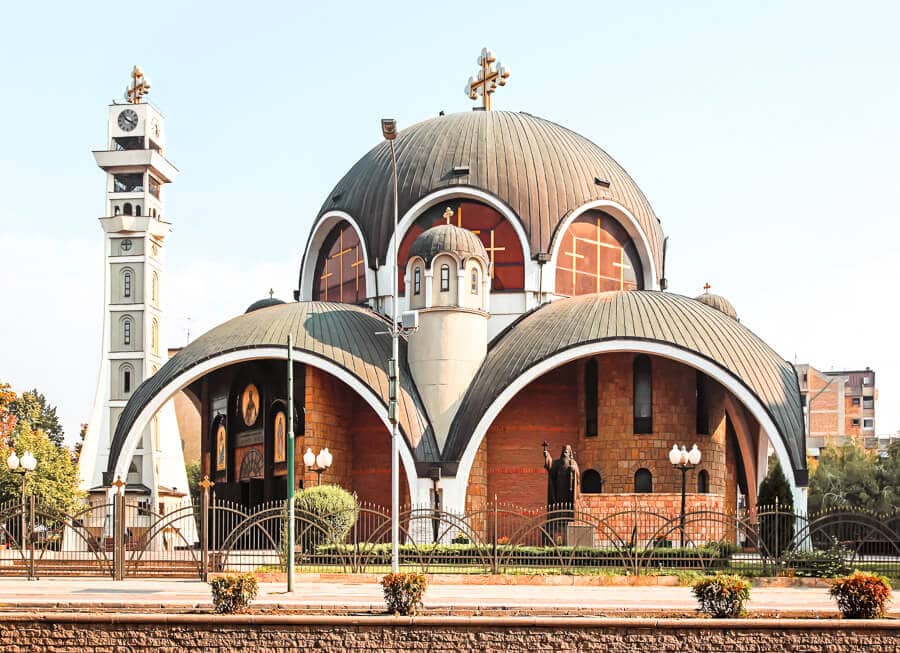
As you wander east from Debar Maalo into central Skopje, stop by Saint Clement of Ohrid Church on the way. The largest Macedonian Orthodox cathedral in the country, this is one of the most distinctive buildings in Skopje and an interesting example of the city’s quirky modernist architecture.
Completed in 1990 by Macedonian architect Slavko Brezovski, the church comprises a series of domes and arches which give it an unusual ‘bubble’ shape. Inside, the wall frescoes and iconoclasts feature beautiful carvings and paintings, including a giant mural of Jesus.
The fountain in front was gifted to the Orthodox church by Skopje’s Islamic community.
Traveller’s tip
If you’re interested in seeing more of Skopje’s unusual modernist and brutalist buildings, read up on the work of Japanese architect Kenzo Tange, who was invited to redesign parts of the city after the earthquake in 1963 (more on this event in a moment). The Skopje Central Post Office, designed by Janko Konstantinov, is another must-see for architecture buffs.
Sadly, there are plans to demolish many of Skopje’s futuristic concrete buildings, so this might be your last chance to see them in person.
3. Count the sculptures in Macedonia Square
Visit time: 20-30 minutes
Get there: 10 minutes’ walk from Saint Clement of Ohrid
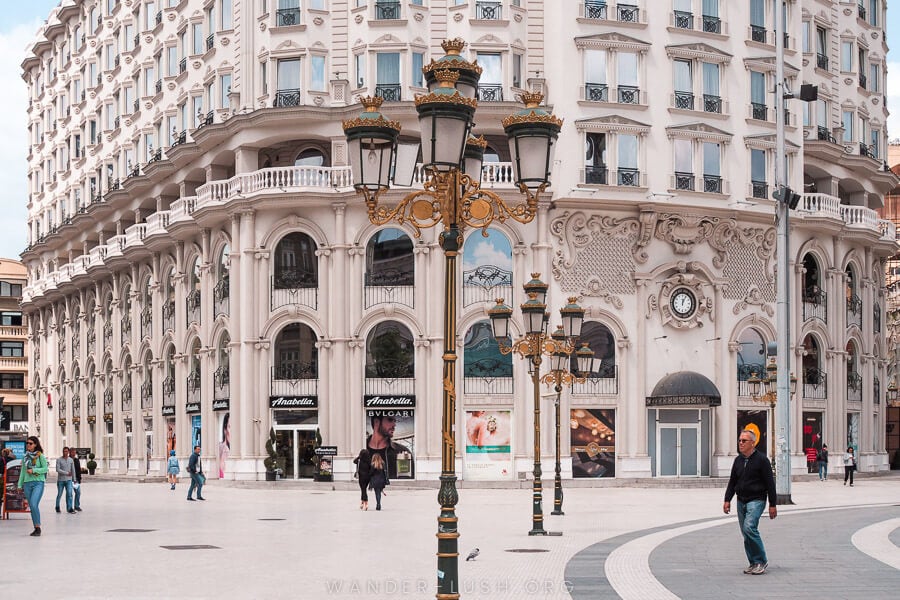
Skopje’s main plaza, Macedonia Square, is unusual because it stretches over both sides of the Vardar River. This is the nucleus of the city and ground zero for Skopje 2014, a massive urban renewal project designed to give the capital a ‘more classical’ feel.
More than 100 sculptures and monuments and 20 new building facades were added to Skopje’s skyline under the controversial and costly scheme, which also sought to reaffirm Macedonian history and identity on the 20th anniversary of the country’s independence from Yugoslavia.
You can see a great many of these new additions when standing in Macedonia Square, including various ministry buildings, museums, and the National Theatre.
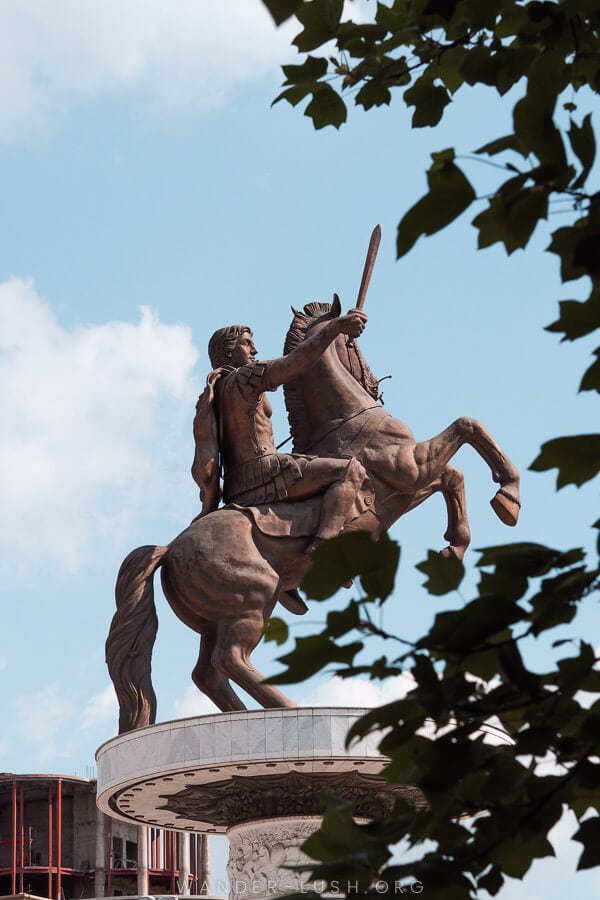
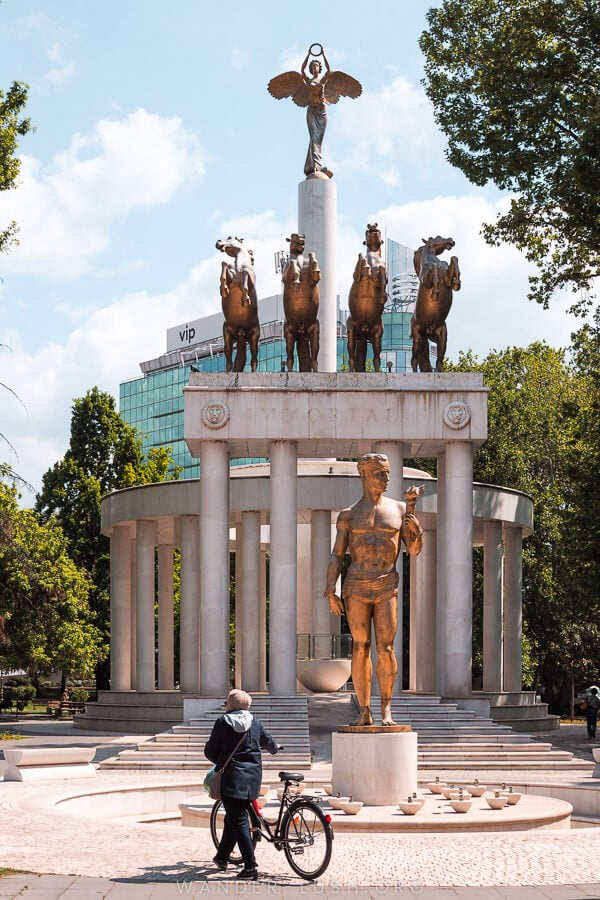
The bronze cast ‘Warrior on a Horse’ monument, unofficially known as ‘Alexander’, stands in the middle of the square. There are cafes and bars all around the periphery, framed by ornate lamp posts, marble pavers that shimmer in the sunlight, and over-the-top plaster moulding.
Beautiful or kitsch – I’ll let you be the judge!
4. Walk through the Macedonia Gate
Visit time: 10 minutes
Get there: 2 minutes’ walk from the centre of Macedonia Square
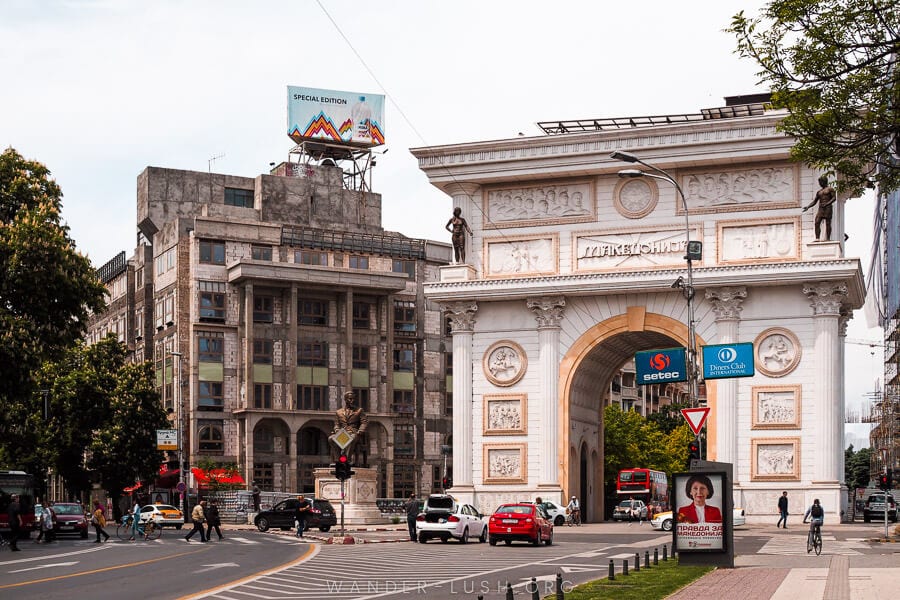
The Macedonia Gate (Porta Macedonia) is a triumphal arch on the south-east side of Macedonia Square. It marks the 11th October Street entrance to the square, itself named after the Macedonian Uprising of 1941.
Much like the Arcul de Triumf in Bucharest, the gate is a symbol of North Macedonia’s struggle for independence.
Finished in January 2012, the arch stands 21 metres tall and is decorated with relief carvings that depict different historical events. Walk around the arch to admire the alabaster-and-gold artworks, or you can venture inside via a doorway inside the arch to visit the souvenir shop, gallery and observation deck.
5. Woman Warrior Park
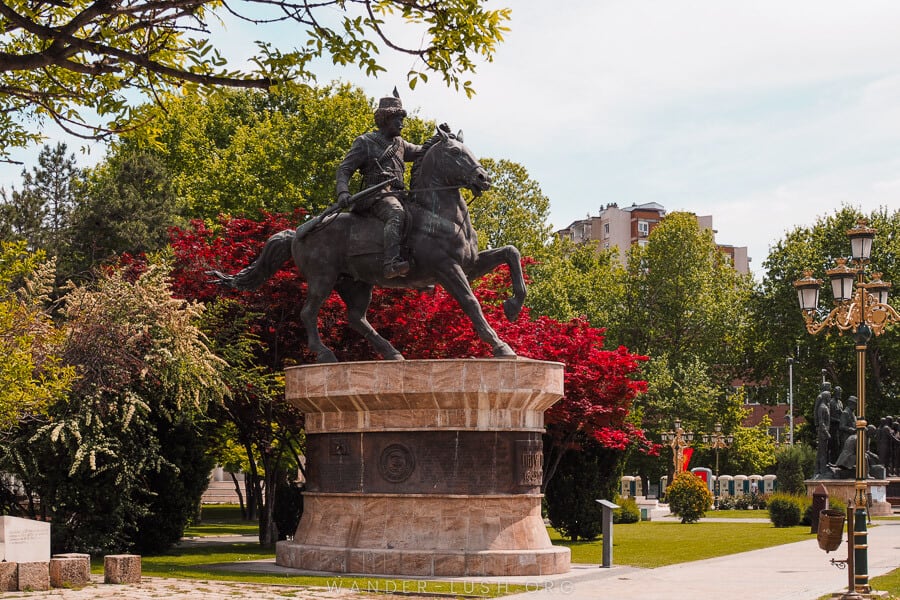
Located just behind the Macedonia Gate on 11th October Street, Woman Warrior Park (Zena Borec Park) contains yet more stone and bronze sculptures, including the distinctive ‘Fallen Heroes of Macedonia’ (pictured above), a set of statue-topped columns that reminded me of Berlin’s Brandenburg Gate.
It’s one of the city’s smaller parks, but it’s well worth walking through to see the sculptures and admire the foliage, which takes on a beautiful rainbow of colours in spring and fall.
Come summer, this is a great place to take a break from the heat of Macedonia Square – all that concrete and polished stone does make things steamy! There are plenty of shady spots to stop for a sit down amongst the groups of friends playing chess.
6. Admire the Art Bridge
Visit time: 10-20 minutes
Get there: 6 minutes’ walk from Woman Warrior Park
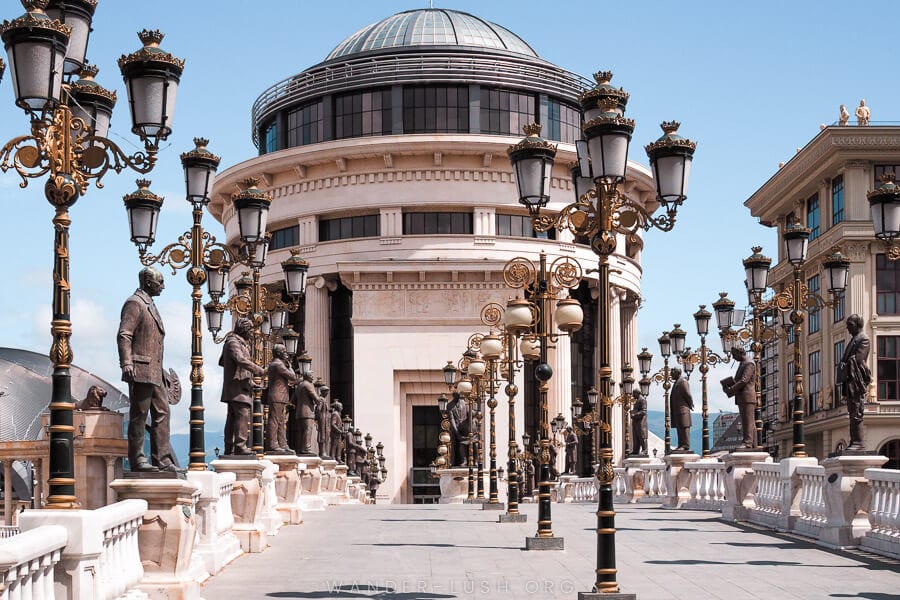
The Art Bridge is one of two new pedestrian bridges built under Skopje 2014. It stretches over the Vardar River, connecting the eastern side of Macedonia Square and Woman Warrior Park to Mother Teresa Square on the opposite bank.
This is one of Skopje’s most iconic attractions and in my eyes, the most beautiful part of the ‘new’ city. When I was in Skopje, the Pope visited for a public mass and many streets and bridges were closed as a result. So I got to see the Art Bridge completely empty – a rare sight, as it’s usually teeming with people!
The bridge is 83 metres long and bestowed with 29 larger-than-life sculptures of noteworthy North Macedonian artists and musicians, including the late pop idol Tose Proeski, who was born in the town of Krusevo and has his commemorative museum there.
The bridge is slightly arched in the middle, and when viewed from either end, the stone railings and central row of lamp posts look perfectly symmetrical. I especially like the aspect from the Macedonia Square side, with the rotunda-shaped Primary Public Prosecutor’s Office in the background.
I suggest walking down one side of the Art Bridge and back along the other. Standing on the bridge, you can see the modern Eye Bridge to the west and the bizarre Happiness Boat floating restaurant docked on the opposite side.
Traveller’s tip: Take a Skopje city tour
If you only have one day in Skopje, it’s well worth taking a guided city tour in the morning. Exploring the city with a local guide will give you a much deeper appreciation for North Macedonian culture and politics, and it will give you clarity on how Skopje has evolved over the years.
Most walking tours start from Macedonia Square at around 10am, so you can easily squeeze a few things in beforehand if you get up early. All include the last three sights mentioned above and typically conclude in the Old Bazaar area.
Of all the itineraries available, I recommend this private walking tour of Skopje with a local guide. It lasts for 4 hours and the start time is completely flexible, so you can get going as early as 8am. Save a spot ahead of time by booking through Get Your Guide.
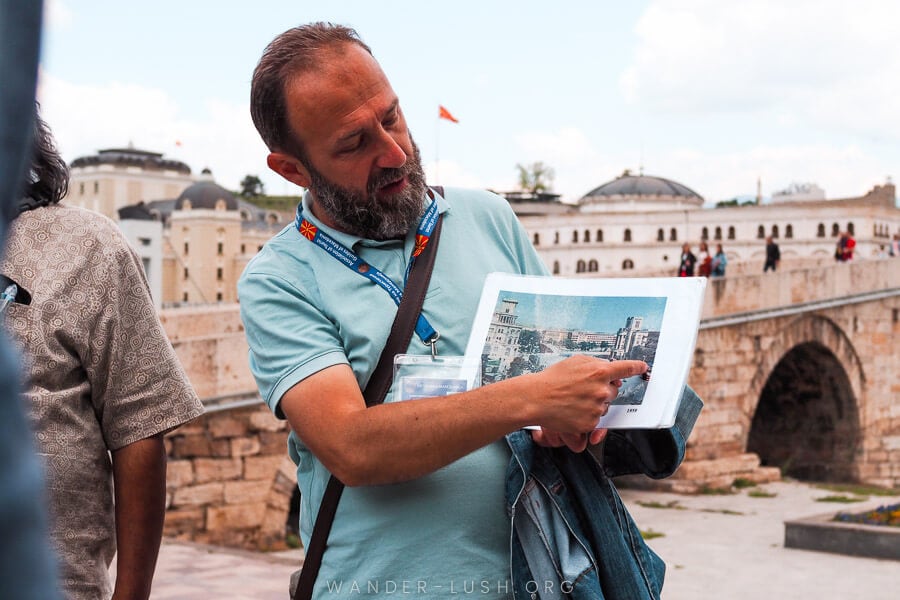
There is also a very good free walking tour in Skopje which we took on a friend’s recommendation. Lead guide Vasko Markovski is absolutely brilliant and really brings Skopje to life with his narrations and local insights.
It’s essential to leave a healthy tip at the end of the tour.
7. Add the Memorial House Mother Teresa to your Skopje itinerary
Visit time: 25-30 minutes
Get there: 10 minutes’ walk from the Art Bridge
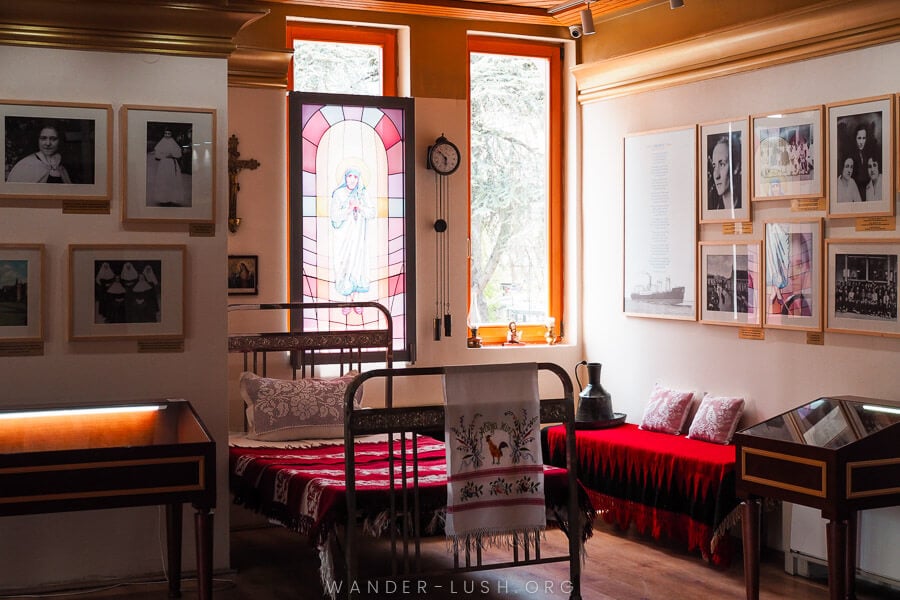
Before crossing the river to visit the old part of Skopje, there are a few more things to see around Macedonia Square. These next two museums are totally optional, but I do recommend visiting both if you have time.
The first is the Memorial House Mother Teresa, which is located just behind Macedonia Square. The 20th century’s most famous Saint – also known as St. Teresa of Calcutta – was born here in Skopje in 1910 and spent her first 18 years in the city.
Her Memorial House features a touching display of photographs, news clippings and personal items associated with her life, including her signature white-and-blue striped sari and a copy of the Nobel Peace Prize she received in 1979. Outside, a plaque marks the original location of her birth house.
Even if you have no interest in Catholic history, it’s worth visiting the memorial to see the building itself – a rather unconventional mishmash of styles, with a tall glass chapel and a viewing deck.
The display of old photographs of Skopje from the early 20th century when North Macedonia was still part of the Ottoman Empire is also quite interesting.
Tips for visiting the Memorial House Mother Teresa
Opening hours: 9am-8pm weekdays & 9am-2pm weekends. Visitors are welcome to attend mass, held at 8am every Tuesday.
Entrance price: Free (including a guide if you want one). All signage is in English.
8. Museum of the City of Skopje
Visit time: 20 minutes
Get there: 4 minutes’ walk from the Memorial House of Mother Teresa
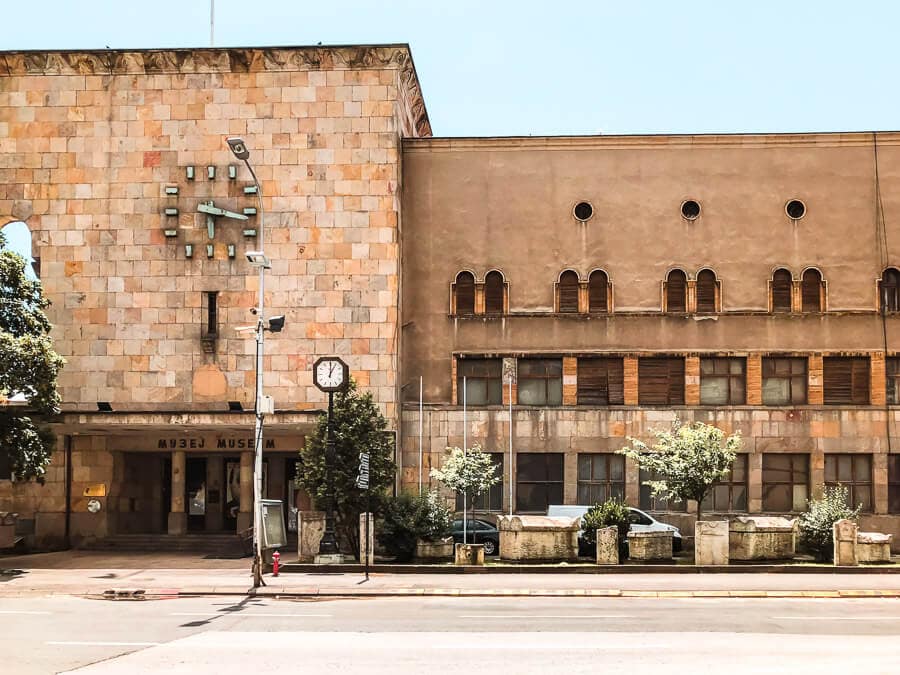
The second Skopje museum that’s well worth a visit is the Museum of the City of Skopje. You can find it at the end of Macedonia Street, a short stroll back from the square.
As the name suggests, the museum displays a collection of photographs, artefacts and ephemera related to the city’s history, from the first recorded settlements in the 2nd century BC up to present day. I especially loved the display of vintage Yugoslav posters.
But the most interesting part of the exhibition is by far the section that covers the 1963 earthquake, a devastating 6.1 magnitude quake that claimed more than 1,000 lives and flattened 80% of Skopje. The reconstructed household scene from the time of the earthquake – including a kitchen turned upside down – is a powerful reminder of the devastation.
The museum’s location is also noteworthy: It’s housed in the old Skopje Railway Station building, itself partially destroyed by the quake. The clock on the building’s facade is frozen at 6.17 – the exact time the earthquake struck.
Tips for visiting the Museum of the City of Skopje
Don’t expect a state-of-the-art museum – when we visited, it was totally empty save for a security guard who flicked the lights on for us. Some of the displays are a bit dated and faded, but there is some information in English. Pay a visit to the original station restrooms while you’re here.
Opening hours: 9am-5pm Tuesday to Saturday & 9am-1pm Sunday (closed Mondays).
Entrance price: 25 denars (approx. 50 US cents) per person.
Afternoon: Old Skopje
9. Cross the Stone Bridge
Visit time: 10 minutes
Get there: 10 minutes’ walk from City Museum via Macedonia Square
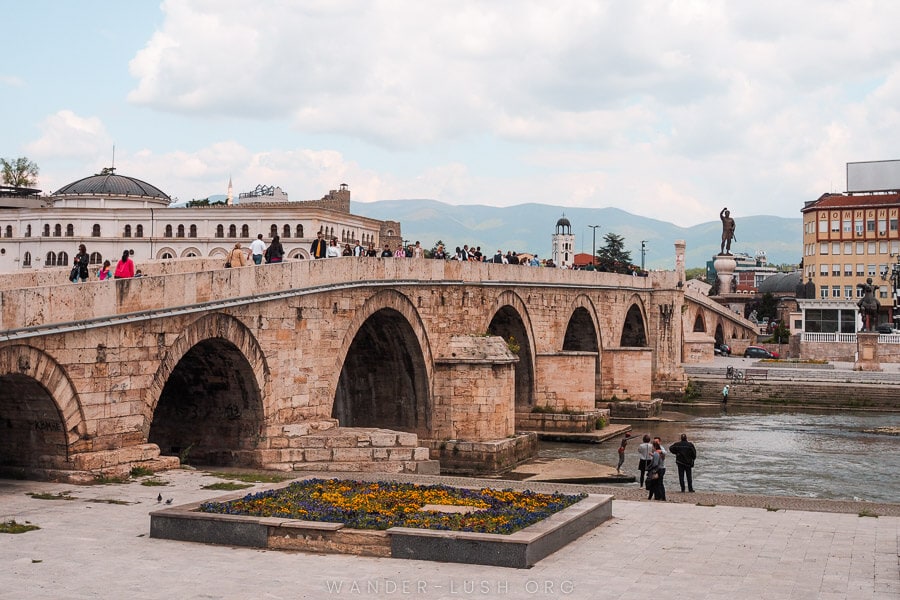
Once you arrive at the foot of the Stone Bridge, you’ll immediately see the contrast between old and new that Skopje is so famous for. A symbol of Skopje, the bridge’s distinctive shape is immortalised on the city’s coat of arms.
The Stone Bridge starts directly in front of Macedonia Square and stretches 200 metres across the river to the Old Bazaar. It was built by the Ottomans in the year 1451 atop foundations that date back to Roman times. The robust stone arches and gently rounded walkway are a feature of many bridges across the Balkans region, including the famous Stari Most in Mostar and the UNESCO-Listed stone bridge in Visegrad.
I mentioned that the Stone Bridge symbolises the division between old and new Skopje. For many locals, it also represents the drift between the city’s different ethnic groups. After you’ve crossed the bridge, you’ll almost immediately notice the difference in urban planning, architecture, and general atmosphere.
10. Daut Pasha Hamam
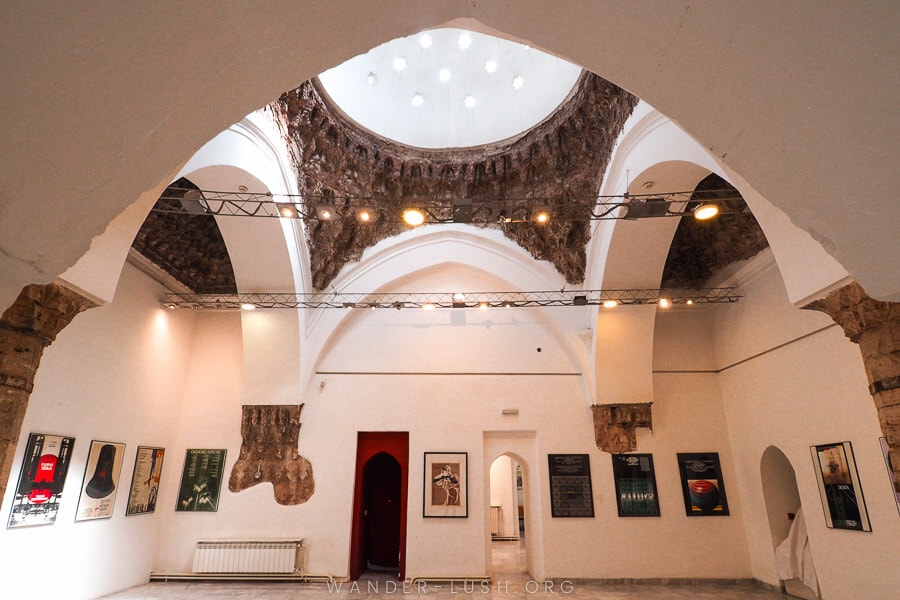
The first point of interest in Old Skopje is Daut Pasha Hamam. You reach the entrance by crossing through Philip II Square, another grand plaza with a huge monument to Philip II of Macedonia in the centre.
This is one of several 15th-century Ottoman bathhouses in North Macedonia that has been converted into an art gallery. (A few hammams in Bitola have received the same treatment, as has the one in Tetovo.) It presents a very unique chance to see this type of architecture up close and from the inside.
The hammam was commissioned by the Grand Vesir of East Rumelia, apparently for the needs of his harem. When he departed Skopje, he left the building to the city. It’s huge by hammam standards, with two parallel zones for males and females, and a series of bathing rooms and dressing rooms set beneath domed roofs.
Cathedral ceilings, polished stone floors and beautiful stonework cornices are just some of the original features on display. The interior has been beautifully restored and most of the walls whitewashed, which adds to the drama.
Some of the domes still have their tiny stone cutouts which let star-bursts of daylight through.
Tips for visiting Daut Pasha Hamam
The exhibition of contemporary art hanging inside the Daut Pasha Hamam is administered by the National Gallery of Macedonia. It’s nice, but nothing special – the main reason to visit is the architecture.
Opening hours: 10am-6pm Tuesday to Sunday (closed Mondays.
Entrance price: 50 denars (approx. 1 USD) per person.
There is a second gallery located inside Cifte Hamam deeper inside the Old Bazaar.
11. Eat Macedonian food at Destan
Visit time: 60 minutes
Get there: 6 minutes’ walk from Daut Pasha Hamam
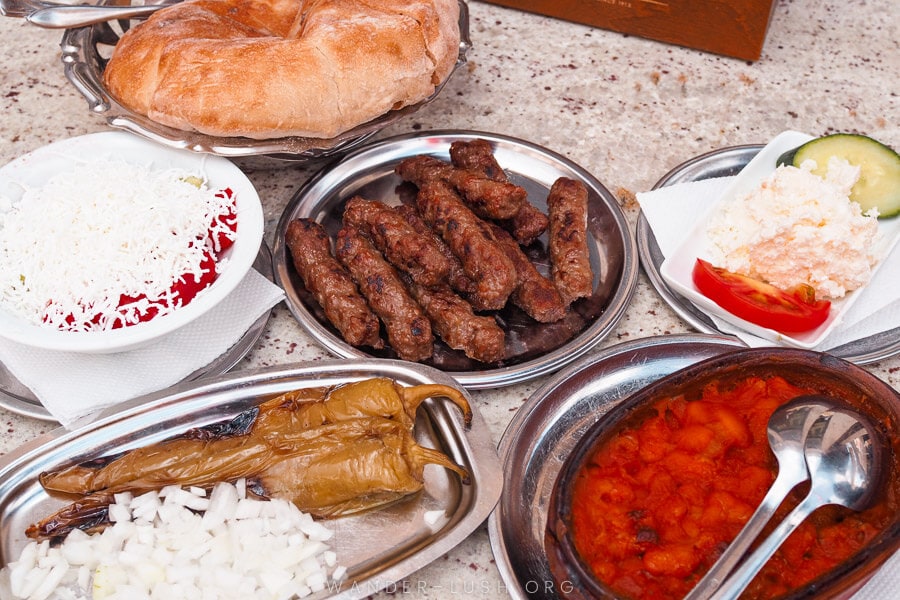
Destan is a good example of an old-school North Macedonian kafana. At least it’s styled that way. It’s a chain brand with restaurants around the city, but my favourite is the one at the entrance to the Old Bazaar, where the tables spill out onto the sidewalk.
Destan has been operating since 1913 and is most famous for its kebab (kebapi), which you might know as cevapi. At Destan, this oily, meaty Balkan staple is best eaten with a refreshing shopska salad (pictured top left under a layer of grated cheese), some ajvar (roasted pepper spread) and kaymak cream cheese on the side. Plus lots of bread, of course.
They also do a tasty version of tavce gravce, North Macedonia’s national dish, but I recommend saving this one for dinner. Don’t eat dessert either – that’s coming up next!
If you fall in love with the food and prices at Destan, there is a second branch in the Debar Maalo neighbourhood and another on Macedonia Square.
12. Grab a sweet treat
Visit time: 20 minutes
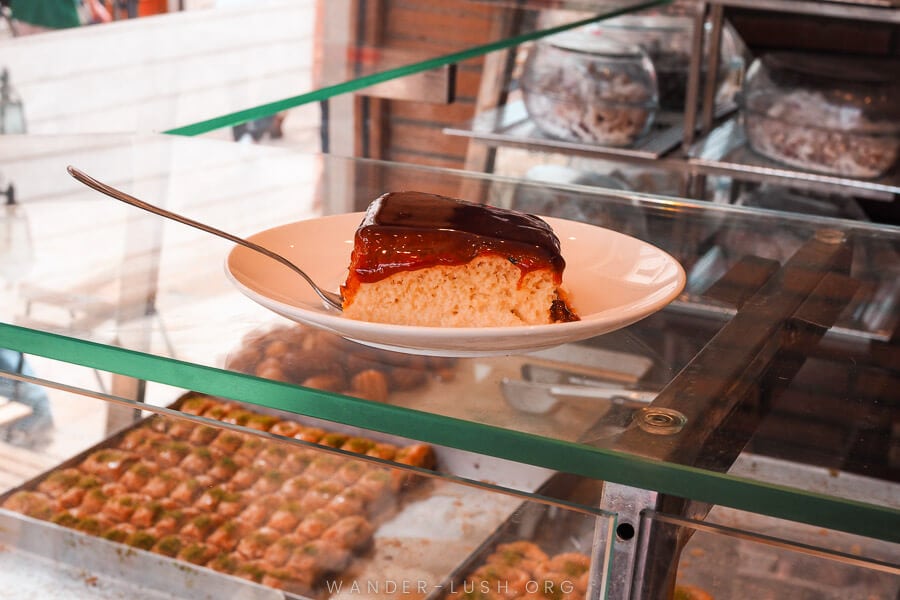
Fair to say that North Macedonia has a sweet tooth. Even I found a lot of the cakes too sweet for my taste – and that’s really saying something. The trick is to pair your dessert with a cup of punchy Turkish coffee to strike the right balance.
There are dozens of atmospheric retro dessert shops inside the Old Bazaar where you can pause for an after-lunch treat. Many sweets are taken from old Ottoman recipes, including kadaif (Skopje’s version of kanafeh), lokum (AKA Turkish delight) and of course baklava, arranged in pretty rows and topped with green pistachio dust.
Another popular choice is trilece, a sponge cake soaked in evaporated milk, condensed milk and heavy cream. It’s calorie-dense and indulgent for sure, but at the same time it can be surprisingly light and subtle in flavour (and not too sweet).
Skopje’s most famous sweet vendor is this woman, who serves baklava, lokma and glistening tulumba (round donuts soaked in syrup) from her little stall inside the Old Bazaar.
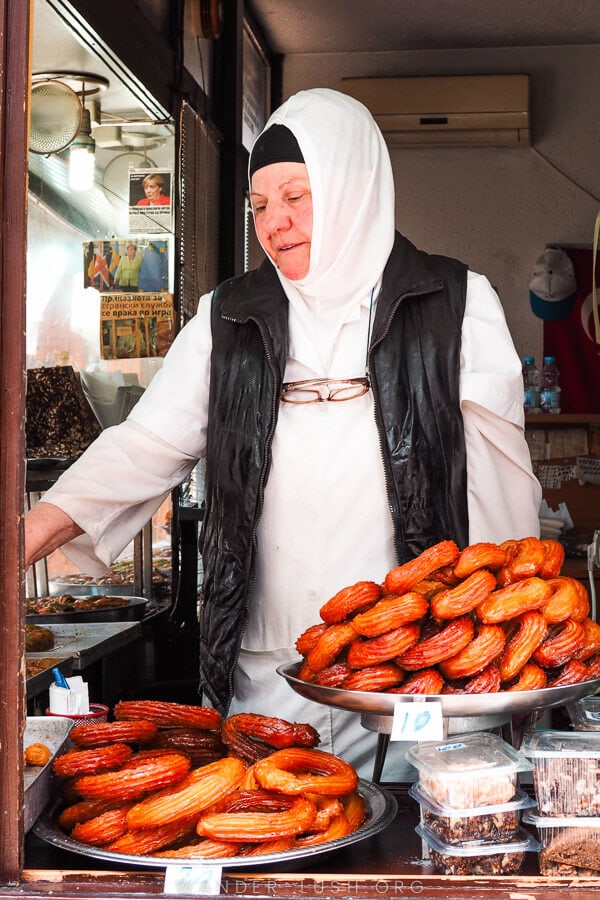
Her shop is called ‘Turska baklava Angela Merkel’. You can’t miss it – it’s the only shop with pictures of German Chancellor Angela Merkel and a huge poster of Turkish President Recep Tayyip Erdogan in the window. There’s usually a line out the front, too.
Other recommended dessert shops inside the Old Bazaar:
- Mado Prom – for delicious trilece (pictured above)
- House Ice Gelato – for the best boza (sweet Turkish smoothie-like fermented drink) and all the desserts
- Baklava Naxho – for excellent baklava
13. Skopje Old Bazaar
Visit time: 1.5-2 hours
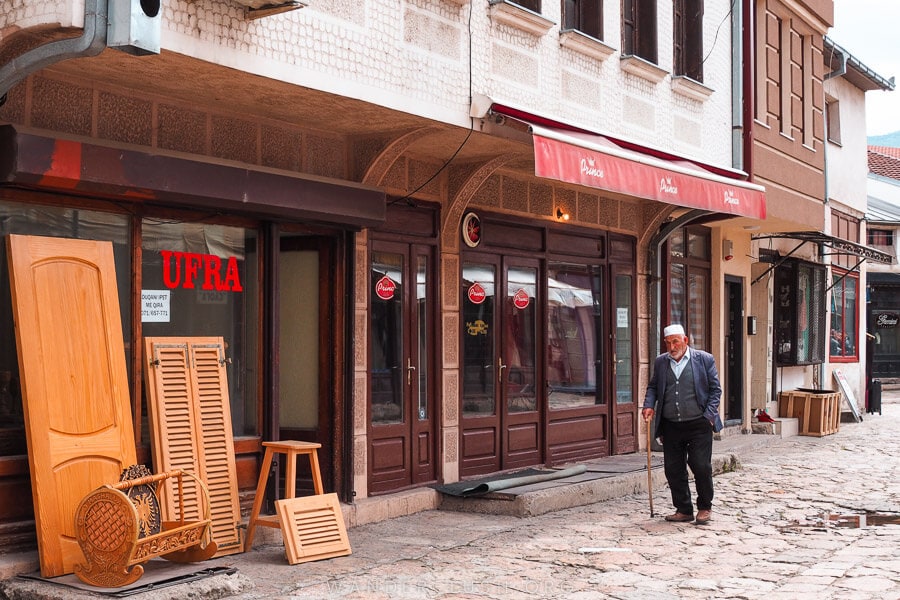
The Old Bazaar is one of the few parts of Skopje that survived the 1963 earthquake. It’s the oldest part of the city and a neighbourhood steeped in heritage and tradition.
In its heyday, this was the second-largest Ottoman bazaar of its kind after the Grand Bazaar in Istanbul. It’s still one of the largest in the Balkans (despite parts of it being gentrified in recent years), stretching from the riverside up to Nikola Karev Boulevard and west to the foot of Skopje Fortress.
The sheer scale of the market goes to show how important Skopje was as a trade centre in years gone by.
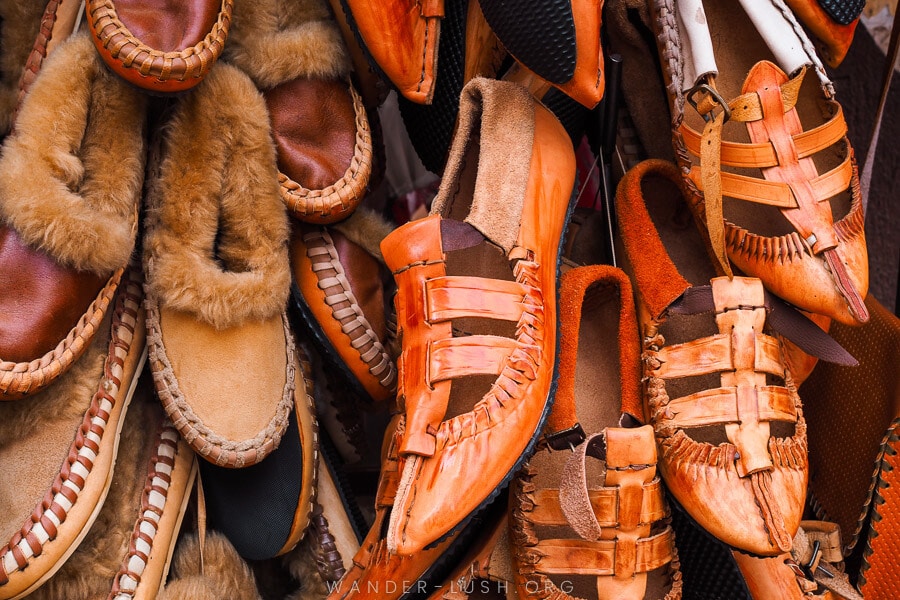
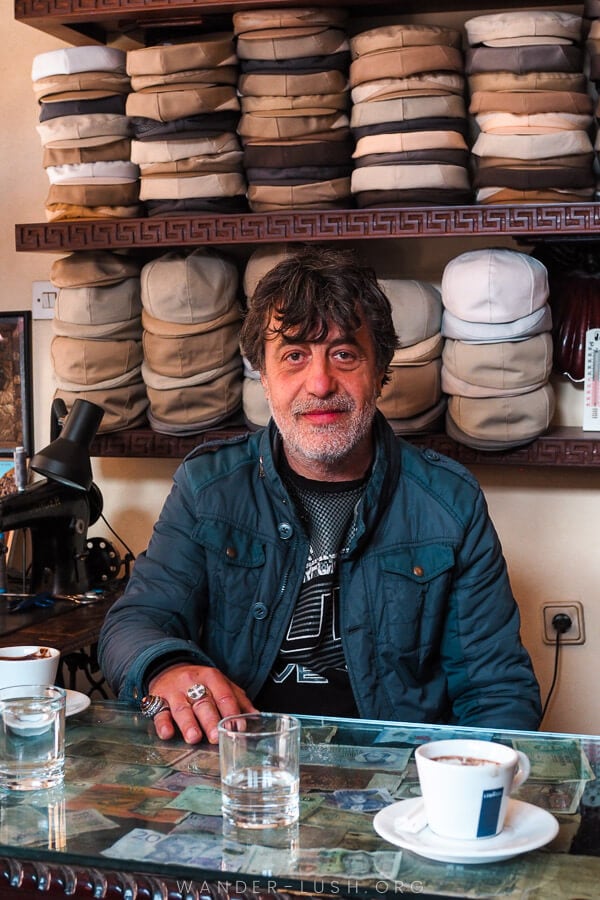
Get lost in the maze of jagged alleys, roam the rows of cute jewellery, clothing and wooden furniture shops, and go inside the undercover shopping area, called the bedesten.
When it was built, every shop in the Old Bazaar was designed to have a uniformly sized floorspace and frontage, a measure to ensure equity between Muslim and Christian traders.
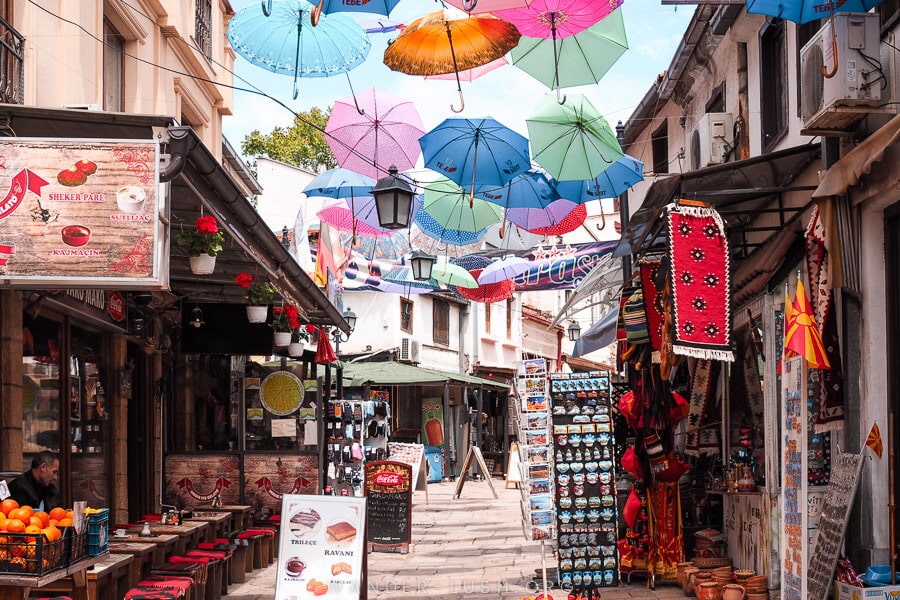
Specialty crafts such as leather shoemaking, goldsmithing and millinery all had their own dedicated streets – just like in Sarajevo’s Old Bazaar and Hanoi’s Old Quarter – although this tradition has mostly been lost to time. During my visit, I got to sit down and chat with Iljco Trajkovski, the last hat-maker in Skopje.
Several huge caravanserais (Silk Road trader’s inns also called by their Ottoman name, hans) are located within the Old Bazaar as well, along with mosques, hammams and medressas.
Read my complete guide to visiting Skopje Old Bazaar for a DIY walking tour of the Old Bazaar.
14. Suli An Local History Museum
Visit time: 20-40 minutes
Located within the Old Bazaar area, Suli An is one of the Skopje’s three caravanserais. It was badly damaged during the earthquake but has since been restored and now houses Skopje University’s Academy of Fine Arts.
The small Local History Museum inside deals with the Old Bazaar specifically and exhibits tools, handmade products and other artefacts collected from the area. There are a few recreated rooms that show what the inn would have been like back in the days of the Silk Route.
I didn’t get a chance to visit the museum but it’s on my list for next time.
Tips for visiting Suli An Local History Museum
Opening hours: 8am-2pm Monday to Friday (closed on weekends).
Entrance price: 100 denars (approx. 2 USD) per person.
15. Catch the view from Hotel Arka
Visit time: 60-90 minutes
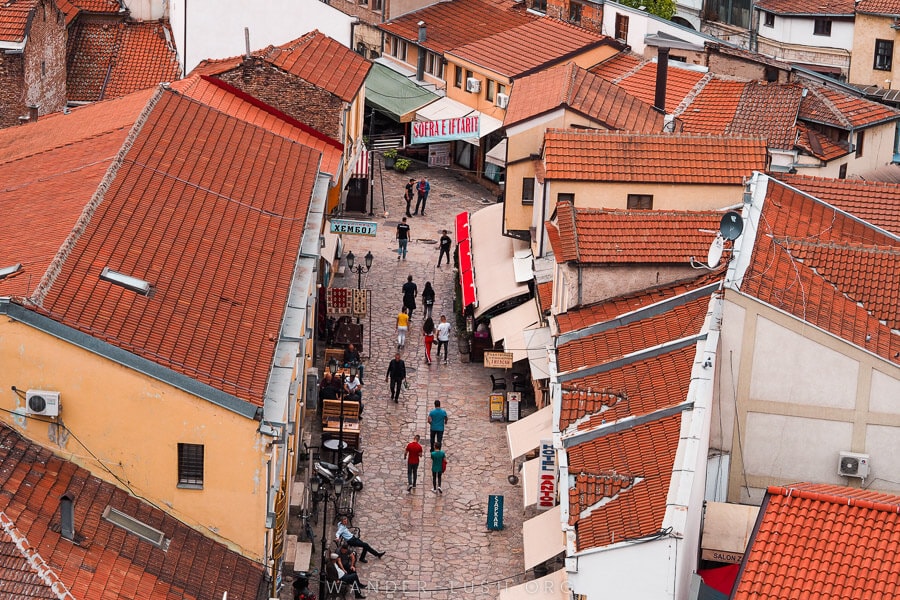
One of the best things to do in Skopje Old Bazaar is head up to the bar at Hotel Arka for a view of the market. I have my friend and fellow blogger Kami to thank for this excellent tip!
One of the tallest buildings in the area, Hotel Arka is located on the eastern side of the Old Bazaar. Enter via the main doors and take the lift to the 7th floor to find the cafe/bar.
Drinks are reasonably priced (we paid 3 Euros for two macchiatos) – and the view is priceless. There is outdoor seating on two terraces, both affording unique vantages over the narrow alleyways and rows of shops.

From up here, you can better appreciate the shape of the han inns with their inner courtyards, and get a feel for just how sprawling the Skopje Old Bazaar really is. You could happily sit up there for hours watching the silent chaos unfold below. It’s really something special.
16. Bit Pazar
Visit time: 30-45 minutes
Get there: 3 minutes’ walk from Hotel Arka
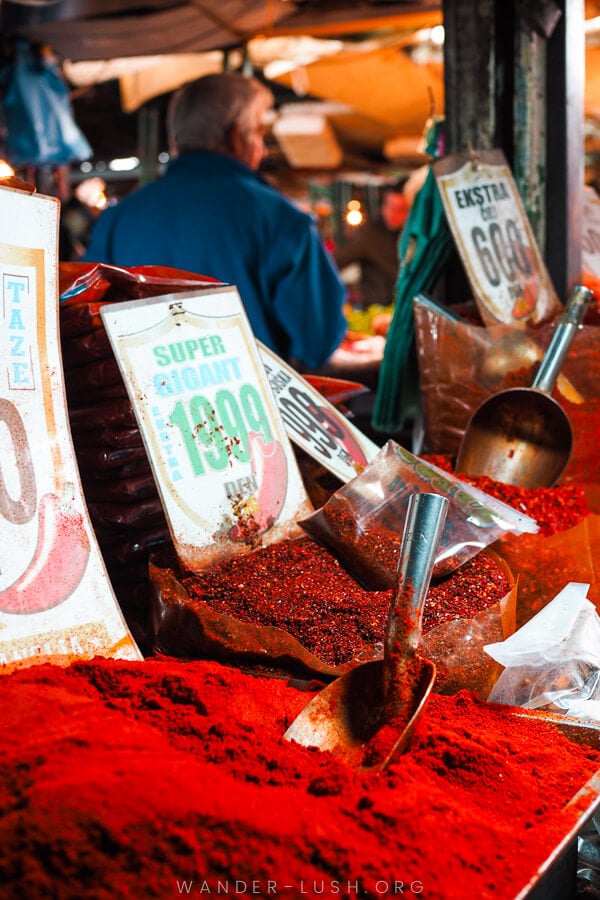
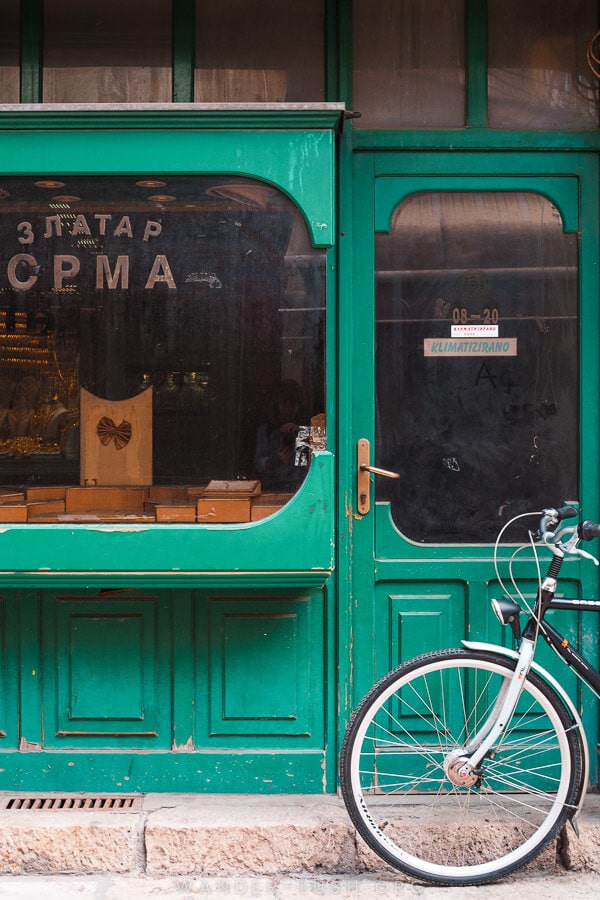
Skopje’s largest and oldest produce market is a separate entity from the Old Bazaar, but the way vendors and shoppers move between the two spaces makes it feel like one huge, cohesive market.
The Bit Pazar (Turkish for ‘Flea Market’) is a hodgepodge of tarpaulin-covered and open-air stalls located at the northern boundary of the Old Bazaar.
Don’t be put off by the first section, which is mostly for apparel and cheap plastic goods. The juicy stuff – the fruit and veg, mountains of richly coloured spices, nuts and loose leaf tobacco – is deeper inside.
Take your time moseying around the colourful displays and deliciously retro shop fronts (I spotted more than one soda fountain in the cafeteria’s around the Pit Bazaar). This is how Skopje’s residents have been doing their shopping for generations.
17. Mustafa Pasha’s Mosque
Visit time: 15 mins
Get there: 6 minutes’ walk from the Bit Pazar

Sitting on a low plateau above the Old Bazaar behind the Museum of Macedonia and beneath the fortress, Mustafa Pasha’s Mosque is one of the most beautiful Islamic buildings in the city.
It was completed in 1492 on the orders of Mustafa Pasha, the same vesir who commissioned the hammam I mentioned earlier. In a word, the design is elegant, all alabaster domes, pretty fountains and rose gardens. The delicate blue paintings under the domes at the front entrance look like Delftware pottery.

Visitors are welcome to visit the mosque without charge outside of prayer times. When we showed up 15 minutes before afternoon prayers and a group of men who had gathered in the garden warmly welcomed us inside.
Note that if you want to go inside the mosque, conservative dress is required and women must cover their hair.
18. Go underground at the Ascension of Jesus Church
Visit time: 15-20 minutes
Get there: 4 minutes’ walk from Mustafa Pasha’s Mosque
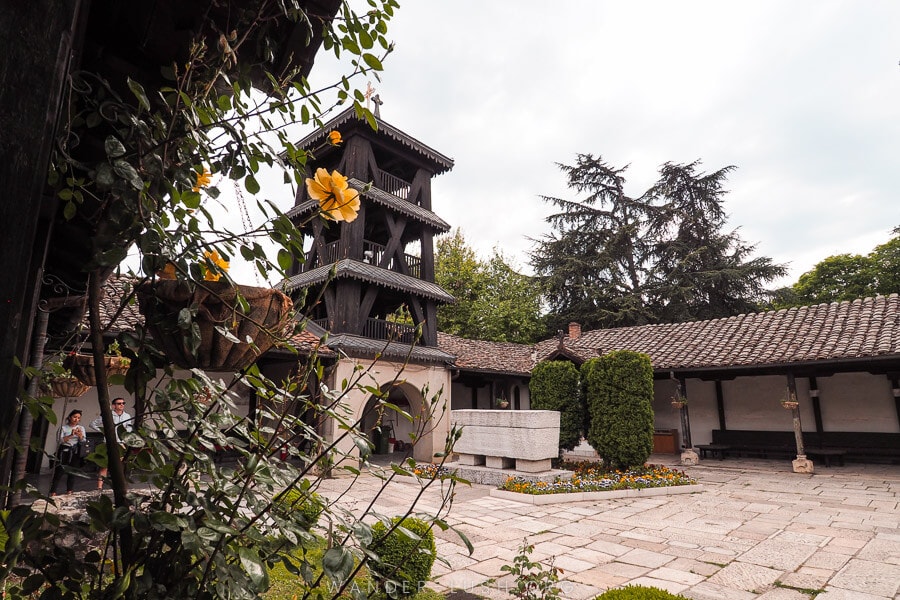
Just around the corner from Mustafa Pasha’s you’ll find one of the only religious buildings in the Old Bazaar area that’s not a mosque. This tiny church is sealed off with a high brick wall and is easy to miss as a result.
Turns out this design feature is intentional. During the Ottoman period, the Turks forbid the construction of new churches until the last days of the Empire when the rules were relaxed. Churches like Ascension of Jesus had to comply with strict rules and weren’t allowed to feature prominently on the city’s skyline. They certainly couldn’t reach higher than a mosque’s minaret.
Thus the chapel was built underground, sunken into the earth and enclosed by a high stone wall for good measure. Today you can visit the pretty courtyard that holds the graves of several notable figures (including revolutionary hero Goce Delčev), view the unusual wooden tower that was added later, and venture into the church itself, which incorporates frescoes from an older chapel destroyed by fire in 1689.
It’s worth paying the ticket price to go downstairs and see the iconoclast, an extravagant piece of woodwork that measures 10 by seven metres and is known throughout the country as one of the best examples of Macedonian woodcarving.
Rumour has it that in the 1920s, the British Museum tried to acquire the iconoclast by offering Skopje a blank cheque. They decided to hold onto it!
Tips for visiting the Ascension of Jesus Church
Opening hours: 9am-5pm Tuesday to Friday & 9am-3pm Saturday and Sunday (closed Mondays).
Entrance price: 120 denars (approx. 2.30 USD) per person.
Note that photography is not permitted inside the church.
Evening: Sunset at Skopje Fortress
19. Climb Skopje Fortress for a view
Visit time: 20-40 minutes
Get there: 4 minutes’ walk from the Ascension of Jesus Church

As your day in Skopje winds down, there’s only one way to go – up. Skopje Fortress (AKA Kale Fortress or Tvrdina Kale) is located on the western edge of the Old Bazaar and is the perfect place to finish your Skopje itinerary with some breathtaking city and sunset views.
The fortifications were built in the 10th century and added to during Ottoman times, when there were an estimated 70 towers in total. Just three are left standing today. Visitors can climb up the towers and walk along the walls that connect them, all the while looking down over the river and Skopje’s newer half.
The eastern walls were still closed for restoration at the time of our visit, but once complete, they should afford lovely views over the Old Bazaar.
Tips for visiting Skopje Fortress
Take care when climbing the walls as some stairs are broken and the rocks have crumbled away in some sections. If you’re travelling with kids, be extra careful as there are no safety rails to guard you from the sheer drop.
Opening hours: 8am-7pm daily.
Entrance price: Free.
20. Drinks at Brewery Old Town
Visit time: 1-2 hours
Get there: 2 minutes’ walk from Skopje Fortress
Brewery Old Town, one of Skopje’s favourite outdoor bars, is located right at the bottom of the fortress, making it the perfect place to stop off for evening drinks before you walk back through the now-silent Old Bazaar.
Craft beer and pizza (or ribs) is the thing to order here. There are a dozen or so brews on tap, and beer tasting trays are available. Outdoor seating is offered in a lovely courtyard, and there’s usually live music on weekends.
21. End your day with dinner inside an old caravanserai
Visit time: 60 minutes
Get there: 4 minutes’ walk from Brewery Old Town
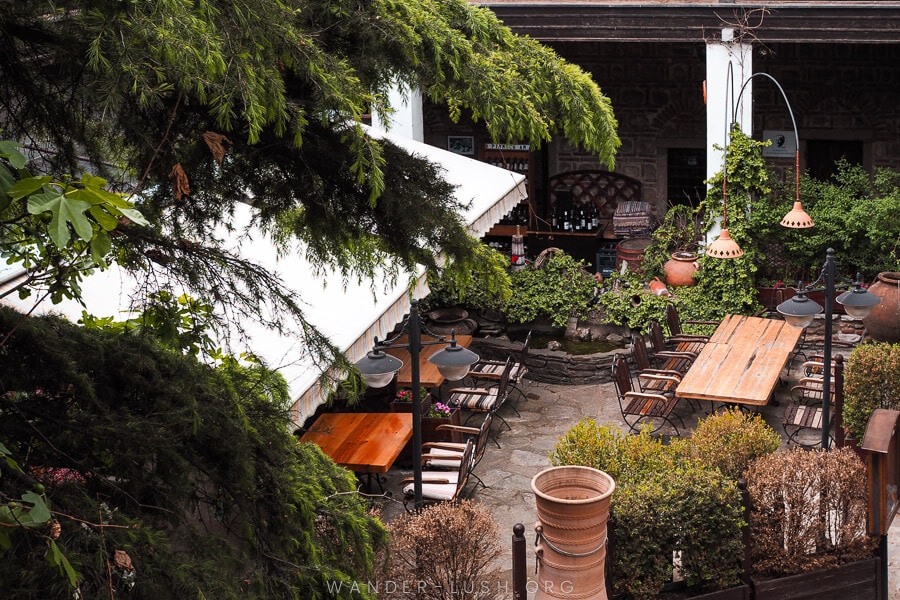
There’s no better way to end a day in Skopje than with dinner in the Old Bazaar. Restaurant Pivnica An is located on the bottom level of the historic Kapan Han, another of Skopje’s 15th-century caravanserais.
The atmosphere is terrific, especially at night when the courtyard is lit up. The menu is great, albeit a touch more expensive than Destan – expect to pay a still-reasonable 300-500 denars (5-10 USD) for a main. I think it’s worth splashing out for the experience of eating inside a stone inn. Mind you, the dining room is located where traders used to stable their animals!
I had a delicious tavce gravce here, North Macedonia’s national dish of flavoursome beans cooked and served in a clay dish. Other specialties include pasha meatballs (veal meatballs in a rich sauce), sarma stuffed grape leaves, and muckalica (pork in a tomato sauce).
This is one of the restaurants in the Old Bazaar that serves alcohol so if you want to order a bottle of local Tikves to go with your meal, this is a good place to do it.
Map of things to do in Skopje
To help you plan your Skopje itinerary, I’ve put all the attractions and restaurants listed above on a handy map.
Click here to access the interactive map on Google Maps and save a copy to your device.

Best day trips from Skopje
If you have extra time to spend in Skopje, consider taking a day trip from the city. National parks, canyons and wineries are all within a few hours’ drive by bus or car.
Matka Canyon – 25km (45 mins) from Skopje

Matka Canyon is Skopje’s most popular day trip. I personally found it a bit underwhelming – but that’s not to say you won’t like it.
The environment is quite pretty and well-kept. The best thing to do in Matka is charter a small boat to take you out on the artificial lake. We paid 400 denars (approx. 8 USD) for a 40-minute jaunt on the water.
Matka is easy to reach from Skopje by local bus #60. If you’re not confident using public transport, you can join a day tour from the city. I recommend this half-day itinerary that also includes Vodno Mountain.
Tetovo – 42km (1 hour) from Skopje
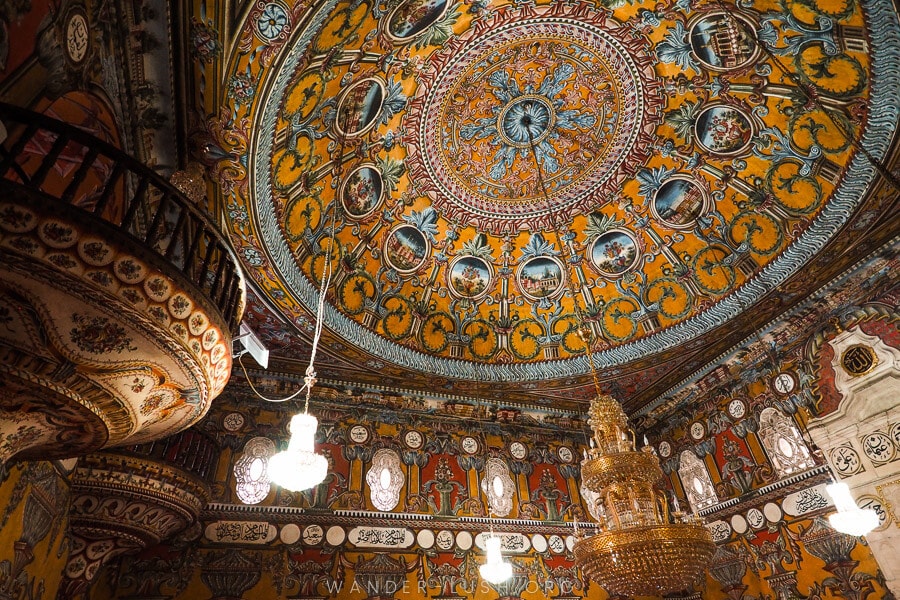
Tetovo was my favourite day trip from Skopje by far. The painted mosque here is unbelievably beautiful (the most magnificent in the Balkans in my opinion) and is honestly a must-see.
Tetovo is a large city and there are frequent bus connections with Skopje taking a little under an hour each way, which makes it one of the easier and shorter day trips on this list.
My detailed guide to visiting Tetovo by bus on a day trip from Skopje includes public transport directions.
Stobi Winery – 80km (1 hour) from Skopje
North Macedonia is fast becoming one of Europe’s premier wine destinations thanks to vineyards like Stobi. Located south of Skopje in the village of Gradsko, this is a great day trip option for anyone who’s interested in learning more about Macedonia’s vineyard culture – or just unwinding with a wine degustation and a delicious meal.
Since public transport is limited (and drink driving is obviously a no-no), I highly recommend visiting Stobi as part of an organised day trip that includes a tour of the wine-making facilities. This four-hour itinerary includes door to door transfers, lunch, and a tasting of four local wines.
Lake Ohrid – 180km (2-3 hours) from Skopje
Lake Ohrid is North Macedonia’s most popular destination and deserves at least two full days. But if you’re really pushed for time or just visiting Skopje as a city break and still want to see the iconic lake, it is possible to get there and back in a day from Skopje if you travel on an organised tour.
This epic 12-hour itinerary hits all the highlights of Ohrid and includes a professional guide plus transfers in a comfortable car. I wouldn’t even think about attempting this day trip independently unless you have your own car. Transfers by public transport are too tight.
Where to stay in Skopje
We stayed at a terrific little Airbnb apartment in Debar Maalo, just west of Centar. As I mentioned earlier, Debar Maalo is Skopje’s bohemian neighbourhood. I highly recommend it for first-time visitors as it’s nice and central while still feeling ‘local’.
How to get to Skopje
Skopje International Airport is serviced by budget carriers from cities across Europe. If you’re flying into North Macedonia, this is likely where you’ll start your trip.
If you’re coming from Ohrid (3 hours), Bitola (2 hours), Prilep (2 hours) or elsewhere in North Macedonia, you can easily find coach buses to Skopje. There are usually multiple services throughout the day. It’s best to check times at the local bus station as the official transport website isn’t reliable (as I discovered the hard way). Skopje’s main bus station is located on the east side of the city, right next to the railway station (see the exact location here).
If you’re entering North Macedonia overland from a neighbouring country, coach or minivan is still the best way to go. There are direct services to Skopje from all neighbouring countries except Greece:
- Bus from Prishtina to Skopje – 2.5-3 hours (this is the route we took)
- Bus from Tirana to Skopje – 5-6 hours
- Bus from Sofia to Skopje – 4-5 hours
- Bus from Nis to Skopje – 3-4 hours
To get to Skopje from Thessaloniki or elsewhere in Greece, you’ll first need to travel by train to Florina near the border, cross to Bitola by taxi (there are no buses or trains), then continue on from there by coach. This journey requires two days – a good excuse to spend a night in lovely Bitola.
Here is my detailed guide to travelling between North Macedonia and Greece.

How to get from Skopje Airport to the city
Skopje International Airport is located 25km (roughly 30 minutes by car) east of the city centre. Unmetered airport taxis are a surefire way to start your trip on the wrong foot, so I recommend pre-booking a transfer instead.
This private transfer costs just 35 USD for a group of up to 3 people and can be organised online through Get Your Guide. I prefer this no-fuss option because it includes drop off right at your hotel.
Alternatively, Vardar Express company operates a bus from Skopje Airport to the city. The fare is 150 denars (approx. 3 USD), and buses are timed to depart when flights land (see the schedule here). You can either get dropped off at the bus station or in the centre near Macedonia Square.
Moving around Skopje
Skopje is super compact and very easy to navigate on foot. It’s mostly flat, too.
Note that there is no Uber (or Uber equivalent) in Skopje yet, so if you want to take a taxi, you have to do it the old fashioned way. A fare across town should be somewhere in the neighbourhood of 200 denars (approx. 4 USD). Remember to always settle the fare before you get in the car.
If you want to travel further beyond the city centre for one of the day trips mentioned above, you’ll need to either join an organised tour (recommended for ease) or figure out the bus system. Buses are the best way to get around North Macedonia as rail connections are limited.
Buying a Skopska card
To ride the bus in Skopje (this goes for city buses, intercity buses and buses to Matka Canyon), you need to purchase a reloadable transit card, called a Skopska card.
I spent a full afternoon trying to buy a Shopska card. It was one of the most frustrating experiences I went through in my entire 6 months in the Balkans – I was tearing my hair out by the end. The issue is finding where to buy the card.
We ended up getting ours from a transport office in the bottom of a shopping centre because news stands don’t sell them. I later found out that you can purchase a card from the main bus station, so if you’re arriving in Skopje by bus, you should definitely pick one up before you leave.
You can find a list of Skopska card resellers here.
When you do manage to find a card, you need to pay 50 denars (approx. 1 USD) for the card itself, plus add credit for fares. A single city bus fare costs 40 denars (approx. 75 cents). I recommend adding a bit extra so that you don’t have to go back and repeat this painful process ever again.
Driving in North Macedonia
If you’re planning on driving around North Macedonia or you just want to hire a car for a couple of days to do some Skopje day trips, several international companies have agencies in the capital. I recommend using Discover Cars to find the best deal on a rental car.
If you’re thinking of doing a Balkan road trip, check out this collection of self-drive itineraries for the best routes around North Macedonia and beyond.
How much to budget for Skopje
Skopje is very affordable by European standards and prices are comparable to other capitals in the Balkans.
We kept a detailed travel budget when we visited. Here is a breakdown of our expenses to help you plan your own Skopje budget.
The local currency in North Macedonia is denars (MKD).
- One night’s accommodation in an Airbnb: Average 4000 denars
- One night’s accommodation in a hostel: 500-700 denars
- Local sim card + data package: 500 denars
- Shopska card: 150 denars
- Single bus fare: 30 denars
- Coffee at a trendy cafe: 120 denars
- Museum entrance fees: 25-50 denars
- Drink at Hotel Arka: 240 denars
- Meal for 2 at a local restaurant (such as Destan): 500 denars
- Meal for 2 at an up-market restaurant (such as Pivnica An): 800 denars
Total budget: 1795 denars (approx. 35 USD) per person, excluding accommodation.
5 things to pack for Skopje
- An anti-theft backpack. As a general rule, Skopje is a pretty safe city. Still, trading your regular day bag for a good anti-theft day pack is worth it for peace of mind.
- A scarf for visiting mosques and churches (women). A lightweight cotton scarf is my number one travel item. In North Macedonia, it’s essential to carry one daily to cover your hair when entering a mosque or Orthodox church, or indeed to drape over your shoulders when visiting a market or a rural area in summer. This neutral travel scarf goes with anything, and it even has a hidden pocket.
- A reusable water bottle. Avoid single-use plastics whenever you can. I love my S’Well water bottle for warm climates because it doesn’t sweat.
- Wine Wings. Local wine is one of the best souvenirs you can take home from Skopje. These handy custom-made bottle protectors will keep your vino safe and sound in your luggage.
- Biodegradable wet wipes. Did you see how icky sticky those donuts at the Skopje Old Bazaar are!? Try this convenient travel pack.
Have you been to North Macedonia? What are your favourite things to do in Skopje? If I missed anything, let me know in the comments below!

Fabulous itinerary, Emily, as usual. You found many places of fascination that we missed in Skopje back in 2016. My only addition would be another museum (of course, in a one-day sprint, museums are something of a liability). The Archeological Museum of (Northern) Macedonia is at the eastern end of the Eye Bridge, and from the outside is ludicrously grandiose of course. Inside, it’s outstanding – well-signed, well-exhibited. The Iron Age origins of Northern Macedonia are described beautifully.
Thank you very much, Steve! I do remember seeing the museum from the outside but sadly I overlooked it. It sounds terrific though – definitely on the list for next time.
Thanks for the tip, I’m sure many readers will find this helpful!